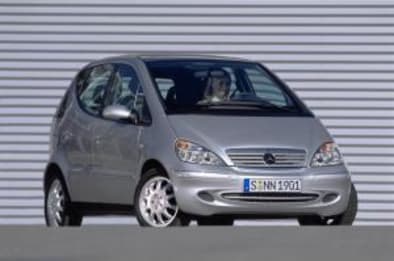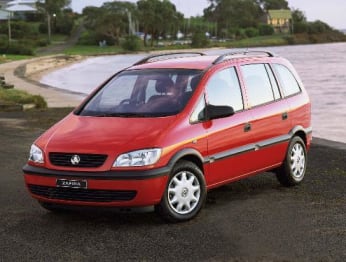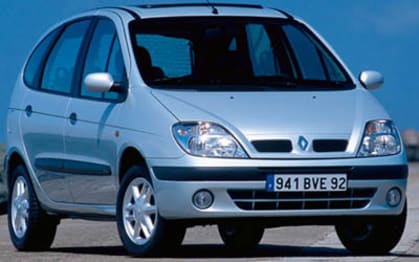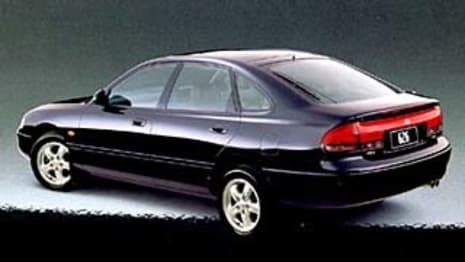
Used Mercedes-Benz A-Class review: 1998-2003
- Mercedes-Benz A-Class
- Mercedes-Benz A 160
- Mercedes-Benz A140
- Mercedes-Benz A190
- Mercedes-Benz A-Class 1998
- Mercedes-Benz A-Class 1999
- Mercedes-Benz A-Class 2000
- Mercedes-Benz A-Class 2001
- Mercedes-Benz A-Class 2002
- Mercedes-Benz A-Class 2003
- Mercedes-Benz A140 2000
- Mercedes-Benz A140 2001
- Mercedes-Benz A160 1998
- Mercedes-Benz A160 1999
- Mercedes-Benz A160 2000
- Mercedes-Benz A160 2002
- Mercedes-Benz A160 2003
- Mercedes-Benz A190 1999
- Mercedes-Benz A-Class Reviews
- Mercedes-Benz A 160 Reviews
- Mercedes-Benz A140 Reviews
- Mercedes-Benz A190 Reviews
- Mercedes-Benz Reviews
- Mercedes-Benz Hatchback Range
- Hatchback
- Mercedes-Benz
- Used Car Reviews
- Buying tips
At the beginning of the 1990s whenever conversations turned to cars the issue of their styling always seemed to come to the surface. The general thrust of the argument over looks was that all cars looked alike, as though they’d been tipped from the same jelly mould, but it was much harder to mount that argument as the decade came to an end when cars like Mercedes A-Class had become a regular sight on our roads.
There was no way you could mistake an A-Class for any other car on the road, it stood out like a beacon of individuality in a bland sea of sameness.
It was also a serious break from tradition for Mercedes-Benz who’d specialised in building medium to big rear-drive cars for most of its long history. The A-Class was a small car, the smallest in the Benz range, and it was front-wheel drive.
The concept was simple, built around efficiency of packaging, using an east-west mounted four-cylinder engine driving the front wheels and placing a wheel at each corner leaving a roomy interior. In effect it was building on the brilliant concept developed 30 years earlier by Sir Alec Issigonis who conceived the Mini.
While the Mercedes idea was a great one it was almost brought undone by a moose in a Scandinavian backwater. A motoring magazine in the wilds of Sweden had a standard test that was meant to simulate a situation in which you had to avoid a moose on the road. In local terms it was like encountering a kangaroo bounding across the road in front of you, pretty much a standard emergency lane change manoeuvre in the rest of the world.
Anyway the A-Class tipped on its side when the magazine put it through its paces against the mythical moose and then proclaimed it unstable in such moves.
Not surprisingly Mercedes went into a tail spin, at first denying there was a problem, but then revising the suspension to improve its stability.
It was an unfortunate start for what was an innovative new look at motoring.
Model watch
The A-Class was conceived as a town car. It used a well founded concept of packaging with the engine, gearbox and driveline in a compact package at the front of the vehicle and a wheel at each corner which left the interior free of intrusion from the mechanics like suspension and tail shafts and the like.
On top of that platform ’Benz built a tall wagon style body with a deep sloping front that offered great visibility and good interior space for such a small car.
At launch Mercedes offered two models, the Classic entry level model and the better equipped Avantgarde.
Initially power came from a 1.6-litre single overhead camshaft fuel-injected four cylinder engine that boasted 75 kW at 5250 revs and 150 Nm of torque.
Buyers could choose from a five-speed auto or a quirky five-speed sequential-shift manual. The latter was an early example of a sequential shift manual, which was a normal manual but allowed you to shift gears simply by moving the lever without the need to operate the clutch.
At the time it was considered quite an advance, a manual gearbox that had the benefits of an auto. The problem was that it wasn’t as smooth as an auto, it drove like a manual so there was a lull in performance as the gearbox shifted gears. There are a number of sequential-shift manual gearboxes available now, and most are smoother and easier to drive than the A-Class was at launch.
The suspension was a blend of MacPherson Struts at the front and a five-link beam with coil springs at the rear, which endowed it with a comfortable ride and balanced handling. Changes made following the magazine moose test made it more responsive to the power rack and pinion steering.
Brakes were a combination of disc front and drum rear, with ABS, electronic brake proportioning, and brake assist standard.
Add to that electronic stability control and there’s quite an array of electronic wizardry helping to keep drivers out of trouble.
The Classic provided entry to A-Class motoring and came with plenty of fruit, including air-conditioning, central locking, cloth trim, power windows, immobiliser, fog lights, dual frontal and front side airbags and six-speaker sound with a CD player.
Tick the Avantgarde box and you received alloy wheels, a cargo cover, leather steering wheel and gear lever, an adjustable steering column, remote central locking, and cloth and leather trim.
A year after launch Mercedes added the A190 Avantgarde, which was an A160 Avantgarde fitted with a 1.9-litre version of the SOHC four-cylinder engine. Power jumped to 92 kW at 5500 revs and torque climbed to 180 Nm.
That was followed in 2000 by the A140, which was identical to the A160 Classic, except for its 60 kW 1.4-litre engine.
An update in 2001 saw the styling freshened with new front-end looks and a revised specification list.
The same update saw the arrival of a longer version, which added 170 mm between to the wheelbase and made the interior even roomier.
In the shop
Generally the A-Class has been reliable with little trouble reported by mechanics and owners.
It’s important to make sure of a service record, one by an acknowledged Mercedes specialist or dealer. If you find a service record from another outlet, check their competence on Benz cars.
Like all Mercedes-Benz cars the A-Class is usually looked after by caring owners who appreciate the value of the investment they’ve made so you’re less likely to find any problems of neglect.
Take careful note of any knocks or clunks you might here on a road test, and observe the transmission for smooth operation without any hesitation in shifting up or down.
Be particularly careful about the sequential manual gearbox, and only consider buying one if you’re into quirky gadgets. The driving experience in my view is less than rewarding and certainly less smooth than a regular auto which I believe is the better choice.
Owners say
Robert Leach and his wife Jenny purchased a new A-Class in 2002, and it has now travelled 19,000 km. This was the first new car for Jenny who had previously driven Robert’s hand-me-downs after he’d driven them for several years.
They looked at a number of cars, particularly the Holden Astra (too squeezy for Robert’s big frame) and the Holden Vectra V6 hatchback (too large to run as a second car) and various Honda, Mazda and Volkswagen models, but Jenny was taken by the A-Class and they have been able to enjoy its attributes over the past three years.
The quality of the materials and fit and finish is evident when compared with other cars and the A-Class contains all the features one expects from European manufacturers.
They were also very taken with the safety of the cabin design and its obvious safety aspects. The list of equipment is very impressive with Traction Control, Stability Control, several airbags, power windows, efficient heating/air conditioning, good sound system and an excellent five-speed automatic transmission.
Given Mercedes' emphasis on safety Robert was surprised to note the rear brakes were only drums although they have not experienced any braking problems. Similarly, the tuning knob for the radio is quite fiddly and hardly adds to safety when tuning on the go and they would have upgraded to push button tuning if they’d thought of it at the time of purchase.
Performance is very good and the A-Class can hold its own on the freeway and on country running. However, Robert says he would not like to be in the seat behind him if they were driving to Sydney as it can be a little cramped in the back if the driver is tall. They also say the fuel economy is excellent.
Entry and exit is terrific as is the slightly elevated view from the front seat. This is one of the best features of the car together with its all-round quality.
Reliability has been good apart from the alternator giving out at 2000 km, but the Mercedes on-road service was very helpful and it was quickly fixed under warranty.
Service from their dealer has been excellent and service costs are not considered too expensive.
The A Class is not a pretty car, they say, but is very practical and has a tremendous character of its own. They love it and would consider buying another one.
In a crash
The A-Class is a nifty handler with plenty of on-board electronics to keep it upright and on the road. Couple that with an array of frontal and side airbags and you have quite an impressive safety picture.
Look for
• adventurous styling stands out a decade after launch
• roomy interior for five
• zippy performance and with good economy
• quirky sequential shift manual a let down
• admirable reliability
The bottom line
Comfortable and well equipped small car makes sense for family transport around town.
Pricing
| Year | Price From | Price To |
|---|---|---|
| 2003 | $3,190 | $6,710 |
| 2002 | $3,190 | $6,710 |
| 2001 | $3,190 | $7,040 |
| 2000 | $3,190 | $7,040 |
| 1999 | $3,190 | $7,040 |
| 1998 | $3,190 | $5,610 |
Pricing guides
Range and Specs
| Vehicle | Specs | Price* | |
|---|---|---|---|
| A160 Classic | 1.6L, ULP, 5 SP AUTO | $3,410 – 5,280 | 2003 Mercedes-Benz A-Class 2003 A160 Classic Pricing and Specs |
| A160 LWB Classic | 1.6L, ULP, 5 SP SEQ | $3,410 – 5,280 | 2003 Mercedes-Benz A-Class 2003 A160 LWB Classic Pricing and Specs |
| A190 LWB Elegance | 1.9L, ULP, 5 SP SEQ | $4,180 – 6,160 | 2003 Mercedes-Benz A-Class 2003 A190 LWB Elegance Pricing and Specs |
| A160 Elegance | 1.6L, ULP, 5 SP SEQ | $3,410 – 5,390 | 2003 Mercedes-Benz A-Class 2003 A160 Elegance Pricing and Specs |
Other cars to consider
$3,410
Lowest price, based on third party pricing data

















